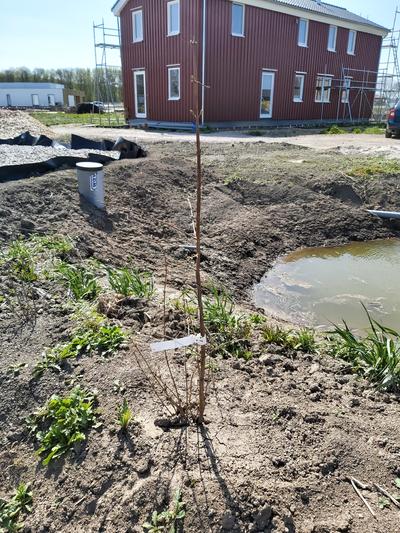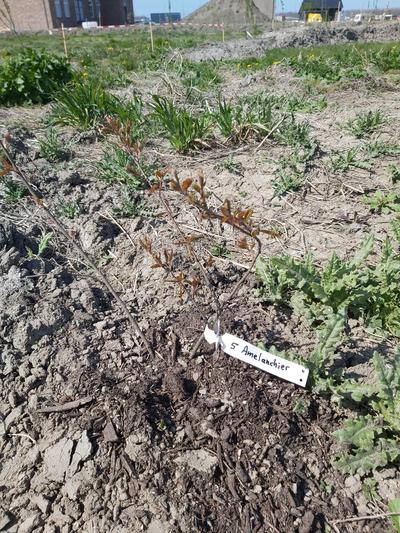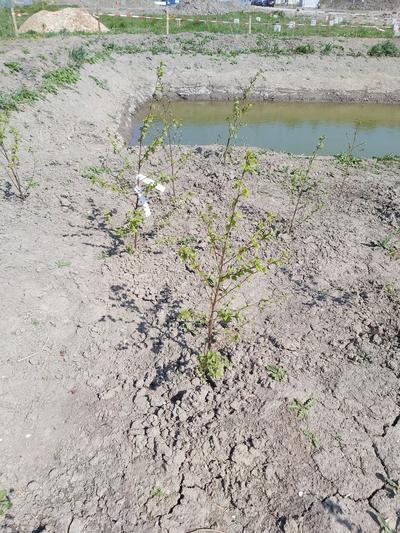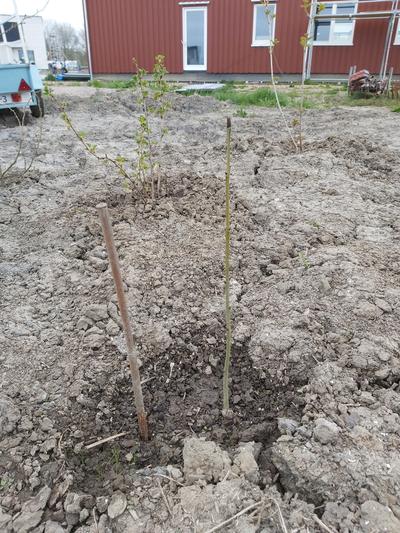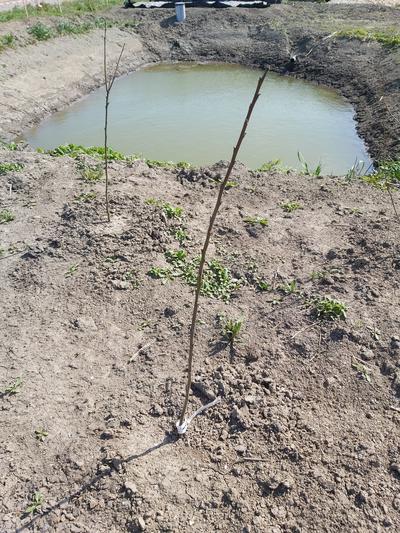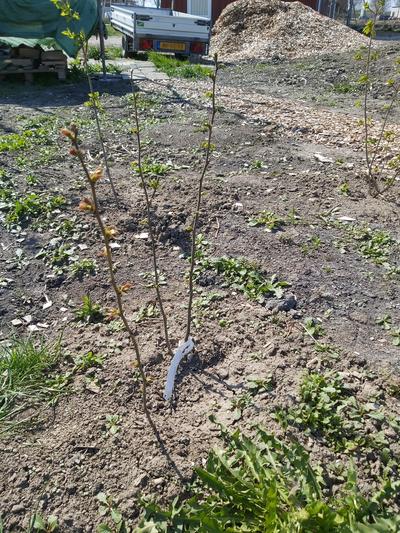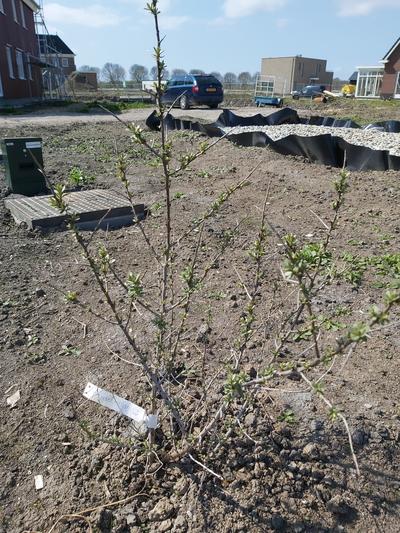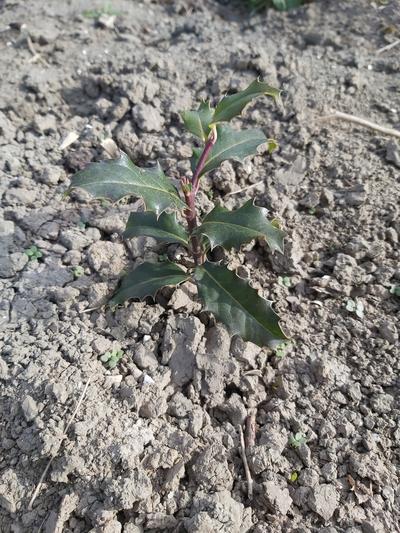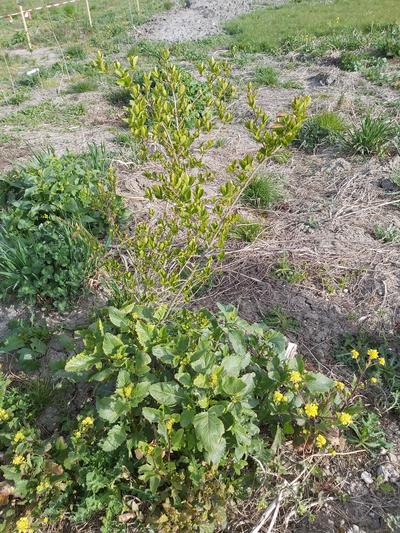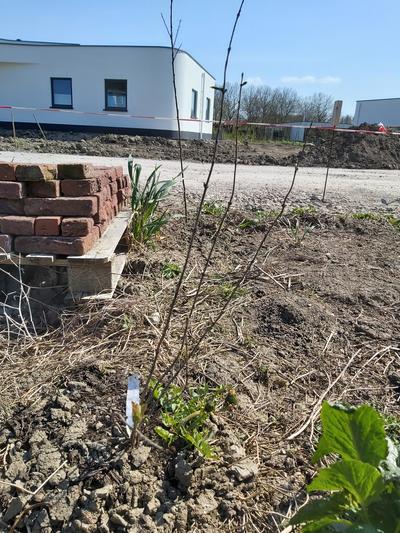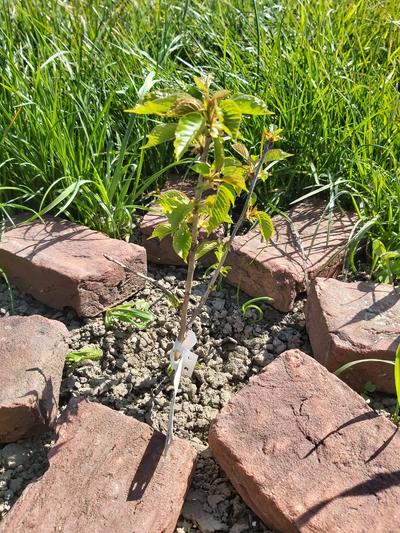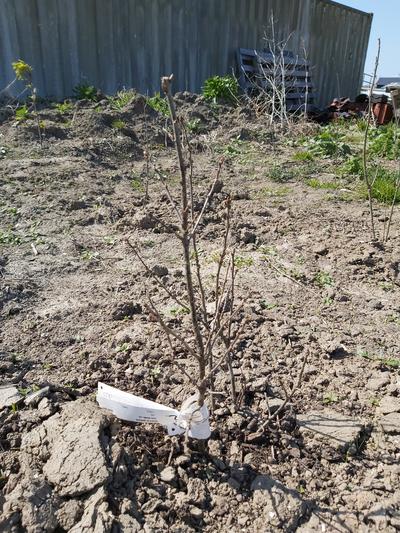| Mounted all fascia boards except the two last |
Good progress putting up red planks |
Finished mounting the horizontal support beams
This week we finished mounting the horizontal support beams of the south wall and finished cutting the first set of planks.
Wednesday 21 April
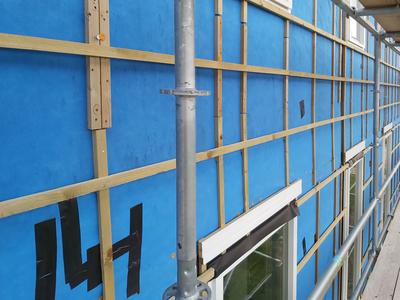 It is Wednesday, and we had a day off to work on the new house. Yesterday it was 20 degrees, but today the weather was back to like it was last weekend—chilly dry wind from the north, 12 degrees Celcius.
It is Wednesday, and we had a day off to work on the new house. Yesterday it was 20 degrees, but today the weather was back to like it was last weekend—chilly dry wind from the north, 12 degrees Celcius.
Until now, we managed to prepare the south wall with the wind from the north. I think next week that luxury is over. I continued on the final two horizontal levels of support beams. Just before lunch, I had fastened the last beam of the upper right corner of the wall.
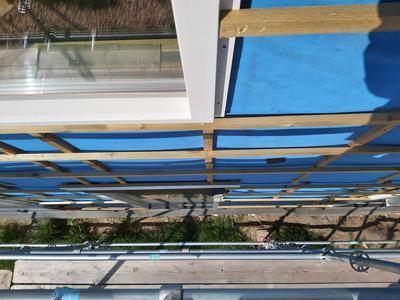 My wife has been busy with the plan for how we put up the vertical red planks. In the plan, we have one particular case of the windows opposite the kitchen and the bedroom on the first floor. The issue we have with these two windows is that the window of the first floor is narrower than the window on the ground floor. We decided to put two planks next to each other beside the narrower window. It had been much easier with a broader window, but it is a little late to think about that now.
My wife has been busy with the plan for how we put up the vertical red planks. In the plan, we have one particular case of the windows opposite the kitchen and the bedroom on the first floor. The issue we have with these two windows is that the window of the first floor is narrower than the window on the ground floor. We decided to put two planks next to each other beside the narrower window. It had been much easier with a broader window, but it is a little late to think about that now.
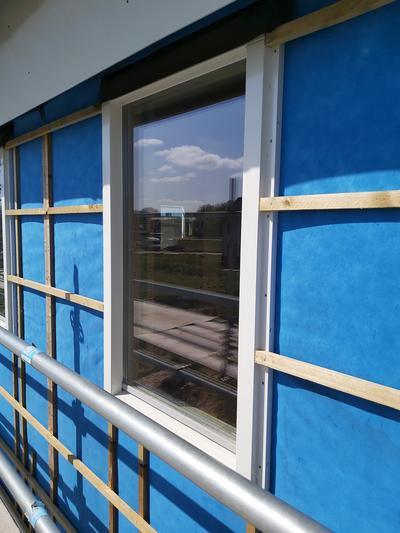
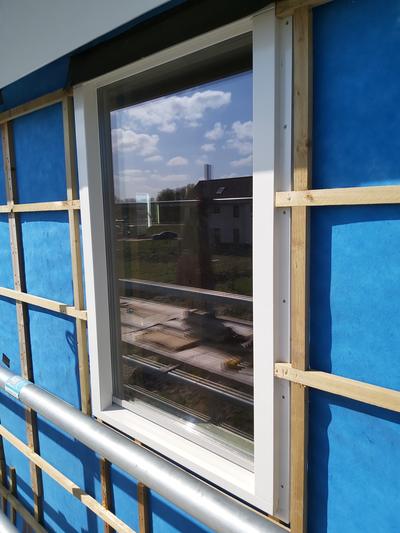 The two planks next to each other at the narrow window need to have support behind the seem. For that purpose, I put vertical beams between the horizontal beams at the same level. That way, moisture, if any, can flow behind these beams.
The two planks next to each other at the narrow window need to have support behind the seem. For that purpose, I put vertical beams between the horizontal beams at the same level. That way, moisture, if any, can flow behind these beams.
This means that all support beams are done!
Next up, we mounted the final fascia boards. The south wall is entirely ready for red planks unless there is some little detail we have forgotten. Soon there is no blue house anymore; it turns into a red house.
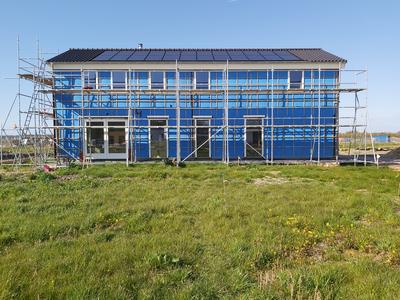
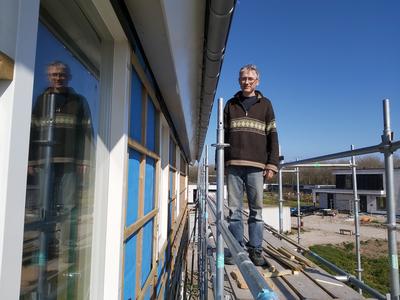 Because of this historical moment, my wife took a photo of me next to the finished support beams and fascia boards.
Because of this historical moment, my wife took a photo of me next to the finished support beams and fascia boards.
I took an hour off from working on the house today. In that hour, I went around our garden and searched for all tags I could find on bushes and trees that we planted. I took a photo of each plant I found with a tag, and I made sure that the photos were tagged with the same tag. Now I can show you the same table as from 8 April of our plants, but this time a photo is included and I even added the name in English.
|
Latin Name |
English Name |
Dutch Name |
Photo |
Our Order, Comments |
|
Acer campestre |
Field maple |
Spaanse aak/Veldesdoorn |
25 |
|
|
Amelanchier lamarckii |
Juneberry/Serviceberry/Shadbush/Snowy Mespilus |
Krent |
5 (but we got 3) |
|
|
Betula pendula |
|
Ruwe Berk |
|
- |
|
Betula pubescens |
Downy birch |
Zachte berk |
25 |
|
|
Fraxinus excelsior |
Ash |
Es |
The top of the branch is called “goats feet” at this stage. |
|
|
Carpinus betulus |
|
Haagbeuk |
|
- |
|
Castanea sativa |
Sweet chestnut |
Tamme kastanje |
25 |
|
|
Cornus mas |
|
Gele kornoelje |
|
- |
|
Cornus sanguinea |
|
Rode kornoelje |
|
- |
|
Corylus avellana |
Common hazel |
Hazelaar |
25 |
|
|
Crataegus laevigata |
|
Tweestijlige meidoorn |
|
- |
|
Crataegus monogyna |
|
Eenstijlige meidoorn |
|
- |
|
Cytisus scoparius |
|
Brem |
|
- |
|
Euonymus europaeus |
|
Kardinaalsmuts |
|
- |
|
Fagus sylvatica |
|
Beuk |
|
- |
|
Fraxinus excelsior |
|
Gewone es |
|
- |
|
Hippophae rhamnoides |
Sea-buckthorn |
Duindoorn |
25 |
|
|
Ilex aquifolium |
Holly |
Hulst |
||
|
Ligustrum vulgare |
Wild privet |
Wilde liguster |
From mother in law |
|
|
Lonicera xylosteum |
Fly honeysuckle |
Rode kamperfoelie |
25 |
|
|
Malus sylvestris |
|
Wilde appel |
|
- |
|
Mespifusgermanica |
|
Wilde mispel |
|
- |
|
Populus alba |
White poplar |
|
|
|
|
Populus nigra |
|
Zwarte populier |
|
- |
|
Prunus avium |
Wild cherry |
Zoete kers / Boskriek |
From neighbors |
|
|
Prunus padus |
|
Inheemse vogelkers |
|
- |
|
Prunus spinosa |
|
Sleedoorn |
|
- |
|
Quercus petraea |
Sessile oak/Cornish oak/Irish oak/Durmast oak |
Wintereik |
25 |
|
|
Quercus robur |
|
Zomereik |
|
- |
|
Rhamnus catharticus |
|
Wegedoorn |
|
- |
|
Rhamnus frangula |
|
Sporkehout/Vuilboom |
|
- |
|
Ribes nigrum |
Blackcurrant/Cassis |
Zwarte bes |
10 |
|
|
Ribes rubrum |
Redcurrant |
Aalbes |
10 |
|
|
Ribes uva-crispa |
Gooseberry |
Kruisbes |
10 |
|
|
Rosa canina |
Dog rose |
Hondsroos |
5 |
|
|
Rosa rubiginosa |
Sweet briar |
Egelantier |
5, the tag of this is missing. Just guessing. Later on, the leaves will smell like sour apples. |
|
|
Salix alba |
|
Schietwilg |
|
- |
|
Salix aurita |
|
Geoorde wilg |
|
- |
|
Salix caprea |
|
Boswilg |
|
- |
|
Salix cinerea |
|
Grauwe wilg |
|
- |
|
Salix fragilis |
|
Kraakwilg |
|
- |
|
Salix triandra |
|
Amandelwilg |
|
- |
|
Salix viminalis |
|
Katwilg |
|
- |
|
Sambucus nigra |
Elderberry |
Gewone Vlier |
25 + Branches we planted last year. |
|
|
Sorbus aucuparia |
Rowan/Mountain-ash |
Lijsterbes |
25 |
|
|
Tilia cordata |
|
Winterlinde |
|
- |
|
Tilia platyphyllos |
|
Zomerlinde |
|
- |
|
Ulex europeus |
|
Gaspeldoorn |
|
- |
|
Ulmus laevis |
|
Steel-/Fladderiep |
|
- |
|
Viburnum opulus |
Guelder rose |
Gelderse Roos |
25 |
I only put in the English names of the sorts we ordered. Last year when we scavenged for trees while we did our lunch walks, we found several sorts not yet on this list. I want to add those to this list as well. I find it challenging to know what sort of plant something is. That is why I need to take photos and document the sorts we have. Only by looking at a plant repeatedly and see how it looks at various times of the year can I follow along. That is the purpose of this is exercise.
I think that already in a couple of weeks, many of these plants have got much more leaves. At that point, it will be nice to make better “portrait photos” of them. I noticed that some of the photos here are blurry, but I will improve on that later. For now, this is what I got.
Saturday 24 April
Today we went to the new house together with our son. His task was to give water to the plants we planted. We received 16 millimeters of rain on 11 April. That is 13 days ago. Since then, we have received minimal amounts of rain. The new plants are not established enough to handle a more extended drought, so we need to give them water.
Today we discovered that the redcurrant and blackcurrant bushes have flowers coming. The apple trees got their bulbs further developed.
The main task for today was to put out marks for where to put planks. The plan for the positions of the planks is finished. We had a sheet printed with the calculations to mark up where the planks will be placed.
Next up, we measured the length of the planks. The wall has different sections with different lengths of planks. We got 14 different lengths of planks on the wall. Then we could count how many of each sort we needed. Now the list of necessary planks was finished. It took a significant part of the day to finish the bill of materials.
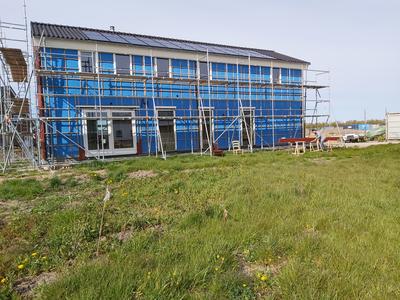 While working on the measurements, I noticed I had made a small mistake with the support beams around the window on Wednesday. There is more space needed for the window sill below the window. I will adjust for that tomorrow
While working on the measurements, I noticed I had made a small mistake with the support beams around the window on Wednesday. There is more space needed for the window sill below the window. I will adjust for that tomorrow
The number of full-length planks is 72, and we still got 92 in the sea container, so we are okay. There is always a bit of waste, but we will use the planks wisely.
We dragged out the first set of planks, marked up to the correct size, and then cut them. It will take days to mark up the planks, cut to length, sand them, paint them. We will make one giant set of all non-full-length planks and leave the mounting until the set is finished. We will see how that is going.
In the afternoon, the ducks came to our pond. They did the evening ritual as they usually do, except today they stayed at our pond to have a nap. They are finding out where there are safe places to stay in the neighborhood. There are other ponds in the area, but I am pretty sure there are dog owners there. We don’t have dogs, so I think our pond might be an excellent place to take a nap.
We were talking about our well today. The water from it got two problems, it contains iron and salt. The iron is no problem when watering plants in a garden. It is worse with the salt. We got our well to be too deep. My wife searched for various plants and how sturdy they are against salt. For example, wild cherries don’t like salt at all. Some plants develop protection against smaller amounts of salt, so if given in a low dose and combined with rainwater, the problem is not so big. In our case, our well is better than nothing, but in the long run, it will not be suitable for our plants. An alternative would be to put a pump in our pond and use the water from there. We have to consider that as well. The water we receive from the municipality is excellent. We pay around one euro per cubic meter, so that is not much.
Covid-19 is coming nearer to us. Our daughter found out today that she got it. She is not living at our old home, she lives in another city where she is studying. We can’t go and help her, and I don’t know what I should do. Suppose she would need groceries etc., it is too far away for us to go and get that for her. Right now, she is feeling fine, but that will eventually change. You don’t know. Luckily she is young and got no risk factor conditions. We hope everything goes fine. That is all we can do right now. In one or two months, we will get our vaccine shot if everything goes as planned. I feel reluctant to get Covid-19 after hiding over a year at home right before the finish line. That would feel like a massive failure for me. If we really need to help her, we will mask up and go and help her, of course. We will see how it goes.
Sunday 25 April
It was supposed to be overcast and colder weather today. Just shy of 8 degrees Celsius. The misery temperature would be 2 degrees Celsius. It was this morning that I found it is called misery temperature, the experienced temperature. We spoke about the weather and the reasonably long-running north wind that we are experiencing right now. We had wind from the north for two weeks now. Why is that? When talking about these things, earth.nullschool.net is the must-go resource. Instead of only talking about it, I took my laptop and showed the program to my wife and son, and we looked around in various menus and looked at the animations of how air flows around the globe. The jetstream lives at 250 hPa. I think the jetstream looks completely obliterated right now. There we found that they had a map in the tool of the misery index, and they defined it as perceived air temperature as the combination of the heat index and wind chill.
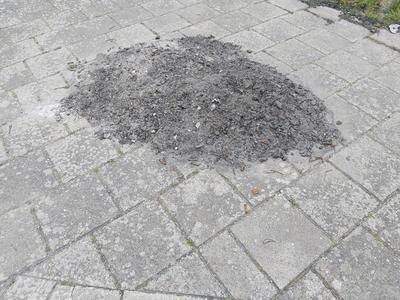 We went to the new house. Outside our old house, we still have the heap of charcoal from the New Years’ celebrations. The heap is much smaller, but it is still there. I think it is part of the ritual to let the junk from the New Year celebration be dispersed by nature. Actually, I don’t know what the purpose is. I am not part of the group of people doing this. It is just a question of time, and this will be a memory of the quirks of the neighborhood where we lived. We will leave it behind us: Pissing dogs, loud motorbikes in the middle of the night, and the practice of leaving junk on the street as part of a ritual to embrace the arrival of the new year.
We went to the new house. Outside our old house, we still have the heap of charcoal from the New Years’ celebrations. The heap is much smaller, but it is still there. I think it is part of the ritual to let the junk from the New Year celebration be dispersed by nature. Actually, I don’t know what the purpose is. I am not part of the group of people doing this. It is just a question of time, and this will be a memory of the quirks of the neighborhood where we lived. We will leave it behind us: Pissing dogs, loud motorbikes in the middle of the night, and the practice of leaving junk on the street as part of a ritual to embrace the arrival of the new year.
We came to the new house and could perceive the misery index in reality. It was indeed feeling like 2 degrees. The plan for today was to continue cut planks to be used for the south wall. We decided on creating one giant set of planks shorter than 5 meters and 40 centimeters. When we finished preparing this set, we have all planks between windows, above windows, next to doors, and so on. Only the full-length planks are missing. That will be the second set. Like I said before, with an extensive set, the only limiting factor is that we need to make room for it to work on it.
When moving around planks and working with them, our trestles are essential. When cutting planks, you quickly need four trestles because you want support for the plank on both sides of the cut. While working through our bill of the material list, we need to store the planks we finished. You can buy more trestles or build your own, but I wanted to use a simple temporary solution, using pallets. Perhaps pallets are not the most admirable solution right now. So what other options do we have? Put the planks on the floor or go and buy more and more trestles. Viable options, all of them, but I wanted to use pallets. We collected a stash of pallets that we used for various tasks throughout, and here was another example of a temporary usage.
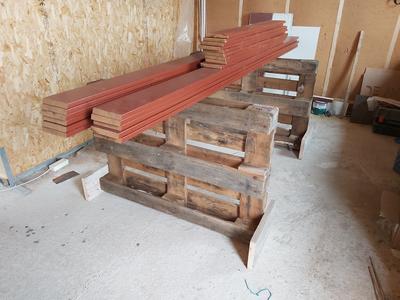 How can you like or not like a solution? A solution is solving a problem. It is positive by definition. Here you can see two pallets with support feet to stabilize them. These pallet trestles can hold a lot of planks.
How can you like or not like a solution? A solution is solving a problem. It is positive by definition. Here you can see two pallets with support feet to stabilize them. These pallet trestles can hold a lot of planks.
The wind was blowing, and it was cold. We took out planks from our storage container and put them on the trestles in front of the house.
There we examined the quality of every plank. If the plank was fine, it went into measuring and cutting. If it was deemed unusable, we carried it back into the container and placed the plank in the scrap heap. For some applications, the entire plank needs to be of good quality. A hole in the middle of the plank makes it go into the scrap heap.
On the other hand, for a shorter piece, the same plank could be used. The same with bowed planks, using it for a full-length plank might not work, but it can perhaps still be used for two smaller lengths.
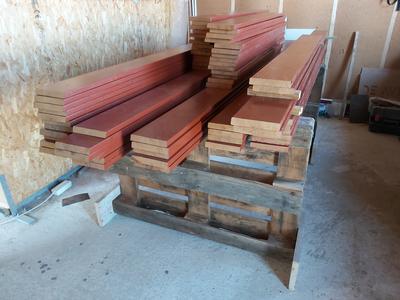 When we got a complete set of planks to cut, the pieces are measured and marked for cutting. Then I saw the planks, and while my wife measures the next set, I move the cut planks into the workroom. We worked like this the entire day.
When we got a complete set of planks to cut, the pieces are measured and marked for cutting. Then I saw the planks, and while my wife measures the next set, I move the cut planks into the workroom. We worked like this the entire day.
With the work today, we made a lot of progress you cannot see on the outside. I suppose neighbors and passers-by will be wondering why it takes so long time to put up a couple of planks on a wall. Well, now we will be sanding these beauties. When that is done, we will paint the ends two times. This will keep us busy for a while. When that is done, we can take out the compressor and the nail gun and our stacks of planks and start nailing the planks to the wall.
I will put up some of the planks with screws, especially where the ventilation will be mounted on the wall. I would like to have one plank on each corner of the wall that I can easily remove to put up, for example, a data cable if that is necessary. Then it is possible to have an outdoor WIFI access point for the garden. That can be useful. Either that or it is possible to put up a weather station on the wall would be cool.
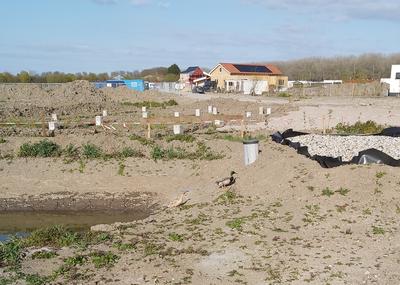 In the afternoon, the sun came forward. It was still cold, but on our personal misery scale, we climbed to pleasant values. Our friends, the ducks, came to visit us, but unfortunately, we disturbed them with our presence. The male took the lead, walking out of the pond. He is responsible for the security in the duck family, and we have not yet proved to him that we are reliable, so off he went with the female duck trailing behind him. Other times she is taking the lead in finding places to find food and exciting places to stay at. He is then dawdling behind her with his head high, looking like a secret agent of a celebrity.
In the afternoon, the sun came forward. It was still cold, but on our personal misery scale, we climbed to pleasant values. Our friends, the ducks, came to visit us, but unfortunately, we disturbed them with our presence. The male took the lead, walking out of the pond. He is responsible for the security in the duck family, and we have not yet proved to him that we are reliable, so off he went with the female duck trailing behind him. Other times she is taking the lead in finding places to find food and exciting places to stay at. He is then dawdling behind her with his head high, looking like a secret agent of a celebrity.
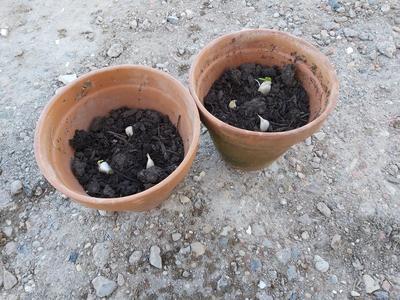 This afternoon I planted six cloves of garlic. I did nothing fancy—first, a layer of wood snippets at the bottom of the pot. On top of that, a layer of the compost we got in a heap in front of our house. I planted the garlic in that layer. Then on top of this garden soil that we had lying in a bag. I have no idea if this will work. That is also the thing with this experience. On gardening, I have minimal experience. This has to be figured out while doing.
This afternoon I planted six cloves of garlic. I did nothing fancy—first, a layer of wood snippets at the bottom of the pot. On top of that, a layer of the compost we got in a heap in front of our house. I planted the garlic in that layer. Then on top of this garden soil that we had lying in a bag. I have no idea if this will work. That is also the thing with this experience. On gardening, I have minimal experience. This has to be figured out while doing.
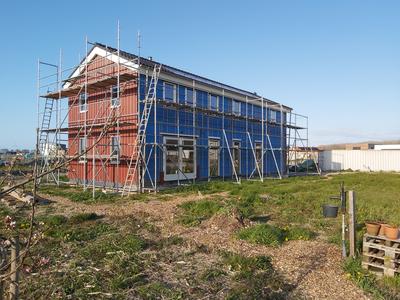 It was a beautiful evening. Not warm, but it looked nice. We discovered grass shouts here and there, but there is not a massive amount of grass that will come. Grass has sprouted in the cracks of the soil on the dyke. Will we get grass only in the cracks?
It was a beautiful evening. Not warm, but it looked nice. We discovered grass shouts here and there, but there is not a massive amount of grass that will come. Grass has sprouted in the cracks of the soil on the dyke. Will we get grass only in the cracks?
With the garlic project, the activities of this week have come to an end.
When I summarize this week, one of the thoughts that I get is that the Covid-19 decease is coming nearer to us. We got colleagues who got it, and now our daughter got it. We really have no time to get sick in Covid-19. We are making steady progress on the south wall. The first set of planks is cut. We will continue preparing that until all of the planks are ready to be mounted on the wall.







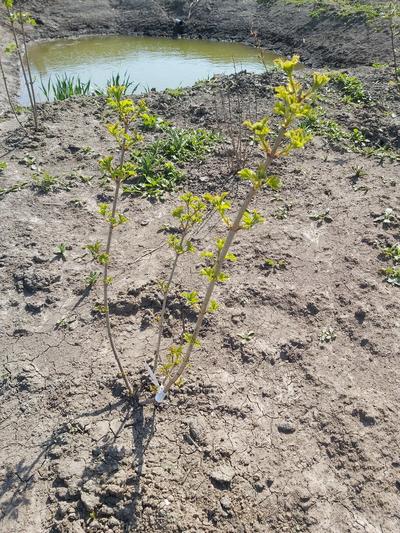
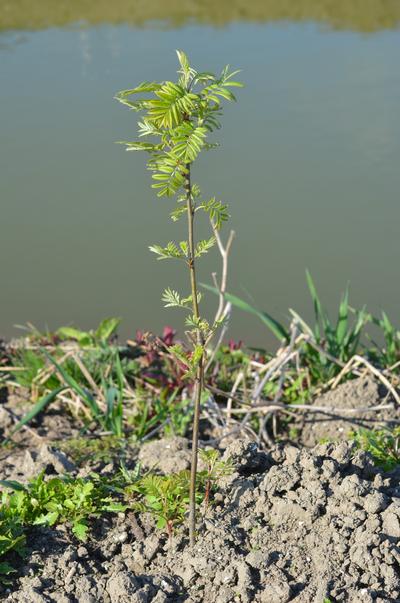
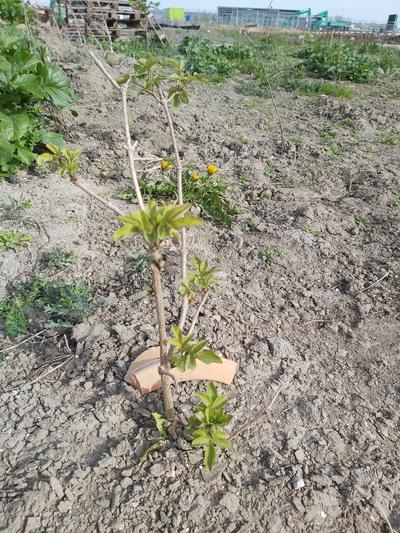
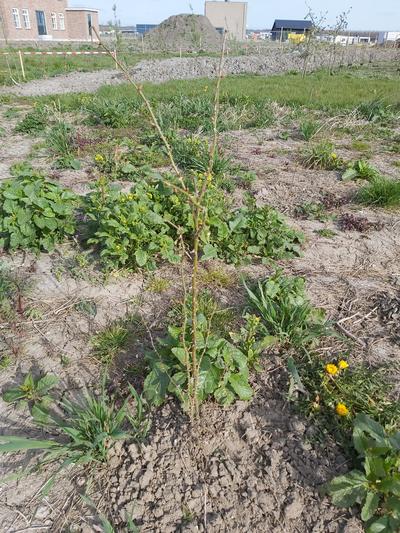
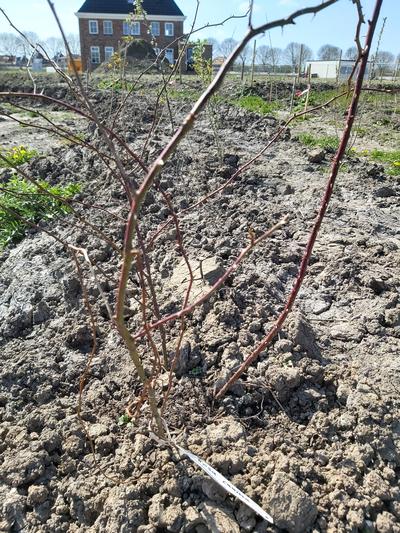
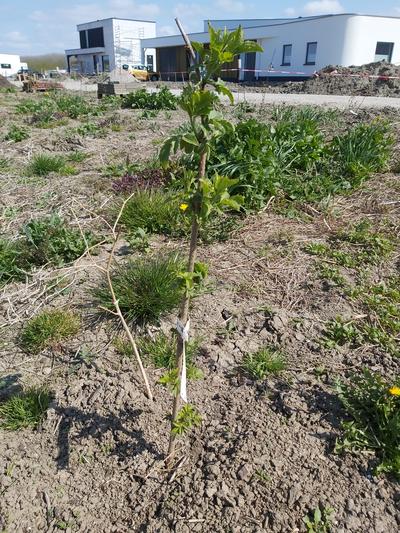
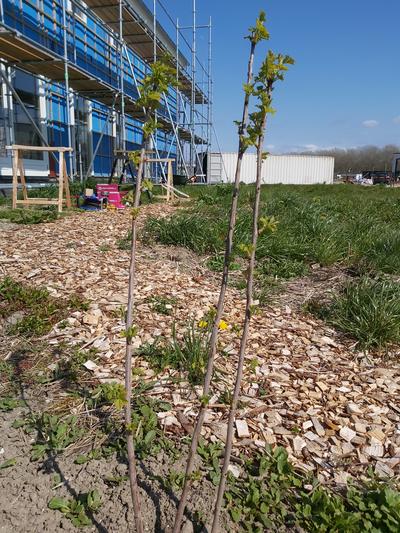
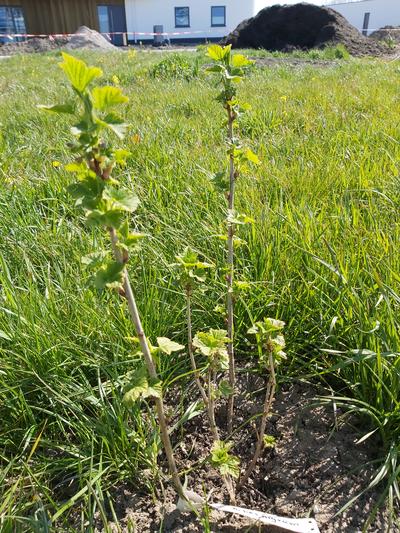 More gypsum boards in the barnThe lamps in the hallway were installedInstalled more lamp fixturesLight installationsSea container picked upSea container soldFinished cleaning the sea containerNice sunrise picturesGreat progress in the barnSeacontainer on saleSea container is empty!Sea container almost empty!Moving planksThis week no activities in the barnAll tiles mounted
More gypsum boards in the barnThe lamps in the hallway were installedInstalled more lamp fixturesLight installationsSea container picked upSea container soldFinished cleaning the sea containerNice sunrise picturesGreat progress in the barnSeacontainer on saleSea container is empty!Sea container almost empty!Moving planksThis week no activities in the barnAll tiles mounted I moved from Sweden to The Netherlands in 1995.
I moved from Sweden to The Netherlands in 1995.
Here on this site, you find my creations because that is what I do. I create.
